Bicycle road rules and safety
Bicycles are a type of vehicle—when you ride a bicycle on a Queensland road, you have rights and responsibilities like all other road users.
When you ride a bicycle or power-assisted electric bike (also known as an e-bike) you must obey the general road rules the same as other motorists, as well as the specific road rules for bicycle riders. Electric bikes have additional rules you need to follow.
On this page:
- Riding a bicycle
- Carrying people
- Signalling
- Towing with a bicycle
- Riding with a person in a bicycle trailer
- Riding too close to a vehicle
- Riding with care
- Being a traffic hazard
- Crashes
- Keeping left and overtaking
- Bicycle helmets
- Bicycle equipment
- Bicycle equipment for night time and unsafe weather
- Carrying a load on a bicycle
- Riding in a bicycle lane on a road
- Riding on the road shoulder
- Special purpose lanes
- Riding across a road at a crossing
- Riding on a separated path
- Riding on a footpath or shared path
- 'No bicycle' signs and markings
- Bicycle crossing lights
- Bicycle storage areas
- Roundabouts
- Hook turns
- Bicycle riding and mobile phones
- Penalties for bicycle riders
Riding a bicycle
When you ride a bicycle, you must:
- have 1 leg on each side of the seat
- face forwards
- keep at least 1 hand on the handlebars.
Carrying people
You can carry another person if:
- the bicycle is designed to carry more than 1 person and has a passenger seat
- each person is wearing a helmet.
Signalling
You must use a hand signal when you turn right. To do this, extend your right arm out horizontally—at a right angle from the right side of the bicycle. Your hand should be open, with your palm facing forward.
Towing with a bicycle
You must not:
- ride a bicycle that is being towed by another vehicle
- hold on to a moving vehicle while riding a bicycle
- lead an animal while riding a bicycle.
Riding with a person in a bicycle trailer
You can tow a child in or on a bicycle trailer if:
- you are 16 years or older
- the child is under 10 years old and is wearing an approved helmet that is securely fitted and fastened
- the bicycle trailer can safely carry the child.
Riding too close to a vehicle
You must keep at least 2m between you and the back of a vehicle when you follow that vehicle for over 200m.
Riding with care
When riding on roads and paths, you must ride with due care and attention and be considerate of other riders, drivers and pedestrians around you.
Some examples where a rider might not be riding with due care and attention include:
- dangerously swerving in and out of pedestrians on a busy path
- riding at an unsafe speed around a corner where pedestrians might be present.
Make sure you are riding to the conditions and avoid unsafe moves that could put you or others at risk.
Being a traffic hazard
You must avoid being a traffic hazard—do not ride into the path of a driver or pedestrian.
Crashes
A crash can happen with a driver of a vehicle (including car, bicycle or personal mobility device) or pedestrian on a road or road-related area.
Road-related areas can be:
- footpaths
- bicycle paths
- shared paths
- carparks
- other public areas where bikes can be ridden.
If you have a crash, you must:
- stop, remain at the scene and give assistance to anyone who is injured – this can include calling an ambulance for help
- exchange personal information, including name and address, with other people involved in the crash.
If you or anyone else involved in the crash fail to exchange personal information, you must report the incident to the police through the Policelink website or call 131 444.
In an emergency, please call 000 for help.
Keeping left and overtaking
When you ride, you must:
- ride as close as possible to the left side (or on the road shoulder) on a single lane road. Or, you may take up any position within the lane on a multi-lane road
- ride to the left of any oncoming vehicle
- not overtake another vehicle on the left if that vehicle is indicating and turning left
- not overtake another vehicle on the left if it is not safe
- not ride with more than 2 riders side by side unless you are overtaking another rider
- ride no more than 1.5m apart, if travelling beside another rider.
Bicycle helmets
When you ride a bicycle or an electric powered wheeled recreational device or a personal mobility device like a rideable, you must wear an Australian Standard (AS) approved bicycle helmet. You must securely fit and fasten it. An approved bicycle helmet means a helmet that complies with AS 2063 or AS/NZS 2063.
You may only carry passengers on your bicycle if the bicycle is designed to carry passengers. If you carry a passenger on your bicycle, they must also wear an approved helmet, securely fitted and fastened. However, if they are a paying passenger on a 3 or 4 wheeled bicycle, they do not have to wear a helmet.
You do not need to wear a helmet if you have a doctor's certificate stating that, for a specific amount of time, you cannot wear a helmet:
- for medical reasons
- because of a physical characteristic that makes it unreasonable for you to wear one.
If you have a doctor's certificate, you must carry it with you when you ride without a helmet.
You also do not need to wear a helmet if you are a member of a religious group and are wearing a headdress customarily worn by your group, that makes it impractical to wear a helmet.
Helmet attachments
There is no law that prohibits the attachment of a camera or other technology (such as communication equipment) to a bicycle helmet, as long as the helmet remains compliant with the above mentioned standards, and is an approved attachment (according to the helmet manufacturer).
As an alternative to a helmet-mounted camera, you may use a camera mounted on your bicycle or a body-mounted camera.
Bicycle equipment
Every time you ride, your bicycle must have:
- at least 1 working brake
- a working bell, horn or a similar warning device.
Bicycle equipment for night time and unsafe weather
If you ride at night or in weather conditions that make it difficult to see, you must display (either on the bicycle or on you):
- a white light (flashing or steady) that can be clearly seen at least 200m from the front of the bicycle
- a red light (flashing or steady) that can be clearly seen at least 200m from the back of the bicycle
- a red reflector that can be clearly seen at least 50m from behind the bicycle—when a vehicle's headlights shine on it.
Carrying a load on a bicycle
You can carry a load on your bicycle. If you choose to carry a load, you must:
- attach the load to your bicycle in a way that does not make the bicycle unstable
- make sure the load is unlikely to fall from the bicycle.
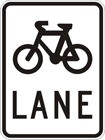
Riding in a bicycle lane on a road
A bicycle lane is a marked lane with either a bicycle lane sign or a road marking of a bicycle symbol and the word 'lane' painted in white. The road may be painted green.
You can choose whether or not to ride in a bicycle lane where one is provided. You must not ride in a bicycle lane on the wrong side of the road (travelling towards oncoming traffic).
Riding on the road shoulder
You can ride on the road shoulder or either side of a continuous white edge line on a bicycle. However, you must give way to vehicles on the road when moving back into the lane from the road shoulder.
Special purpose lanes
You can ride your bicycle in a special purpose lane. A special purpose lane is a marked lane, or part of a marked lane, including:
- bicycle lanes
- bus lanes
- tram lanes
- transit lanes.
Most of the Gold Coast tram system operates on a 'tramway'. A tramway is not a tram lane, or any kind of special purpose lane. Bicycle riders must not travel along the road in a tramway.
Riding across a road at a crossing
Crossings include:
- pedestrian crossings (zebra crossings)
- children's crossings
- signalised pedestrian crossing.
You can ride across pedestrian crossings at traffic lights, if you:
- wait for the green 'walk' sign
- proceed slowly and safely
- give way to any pedestrian on the crossing
- keep to the left of any oncoming bicycle rider.
You can ride across a zebra crossing or children's crossing as long as you:
- come to a complete stop first
- proceed slowly and safely
- give way to any pedestrian on the crossing
- keep to the left of any oncoming bicycle riders.
You must give way to vehicles and other road users at uncontrolled intersections before you ride across.
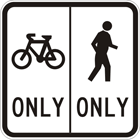
Riding on a separated path
On a separated path, you can only ride on the side that is for bicycle riders. The other side is for pedestrians. The separated path sign will show you which side of the path you must ride on. You must always ride to the left of bicycle riders coming toward you.
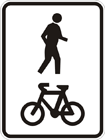
Riding on a footpath or shared path
On footpaths and shared paths, you share the space with pedestrians.
You must:
- keep left and give way to all pedestrians
- always ride to the left of bicycle riders coming toward you.
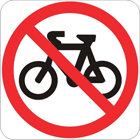
'No bicycle' signs and markings
You cannot ride on a road or path where signs or road markings prohibit bicycles.
Bicycle crossing lights
When riding along the road and facing a red traffic light, do not ride past the red traffic light unless a green bicycle crossing light is also facing you.
When crossing the road at bicycle crossing lights, you must:
- stop before entering the crossing (if the light is red)
- only cross when the light is green
- if the lights change to yellow or red while you are still in the crossing, cross using the safest, most direct route.
Bicycle storage areas
A bicycle storage area is a section of the road, before an intersection with traffic lights, where you can wait (for the traffic lights to change) in front of the stopped vehicles.
A bicycle storage road area will have painted bicycle symbols, be between two parallel stop lines and may be painted green.
Bicycle and motorcycle riders are allowed to cross the first stop line to enter the bicycle storage area but must stop at the second stop line at a red traffic light. Motor vehicles, other than motorcycles, must stop at the first stop line.
A bicycle rider may choose to enter a bicycle storage area from a bicycle lane.
When you enter a bicycle storage area, you must:
- give way to anyone that is already in the bicycle storage area
- give way to any vehicle that is entering the area on a green or yellow traffic light.
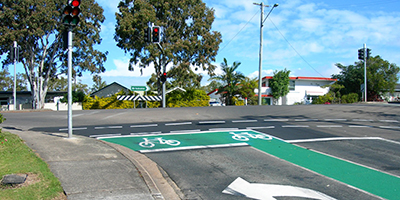
Roundabouts

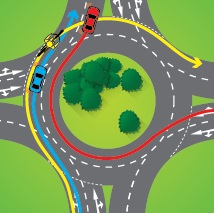
Multi-lane roundabouts
At multi-lane roundabouts, motor vehicle drivers who want to turn right must enter the roundabout and turn from the right lane (unless signs or road markings indicate otherwise). However, when you are riding a bicycle, you may enter the roundabout and turn right from the left or right lane.
It is important that all road users maintain a safe distance behind the vehicle in front to be able to stop safely, if necessary, to avoid a collision. If you choose to turn right from the left lane, you must give way to any motor vehicle that wants to leave the roundabout. If you are already on the roundabout and a motor vehicle is entering they should give way to you.
Roundabouts with only 1 marked lane
In a single-lane roundabout you can choose to take up the whole lane like other road users.
Hook turns
Performing a hook turn
You can turn right at an intersection using a hook turn. The way you should do this depends on whether or not the intersection has traffic lights.
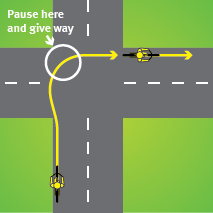
If the intersection has no traffic lights, you should:
- keep to the far left side of the road and move forward through the intersection
- pause and give way to motorists moving through the intersection
- when the road is clear, move forward across the road.
If the intersection has traffic lights, you should:
- move forward through the intersection from the bicycle lane on a green light
- stop in the box or in a safe area in the opposite corner, and turn your bicycle to the right (in the direction of the marked arrow). If there is no line marking for hook turns, you should stop where you are clear of traffic. You will now be facing a red light
- when the light turns green, move forward through the intersection.
Some intersections will have line markings for you to use for hook turns.
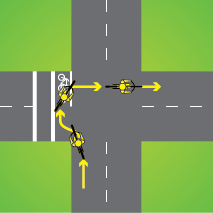
Hook turn storage box
A hook turn storage box is an area marked on the road within an intersection. It shows you where to wait if you are performing a hook turn.
Bicycle riding and mobile phones
To keep yourself and other road users safe your full attention is needed when riding. Holding a mobile phone in your hand or resting it on any part of your body when riding is illegal—even if you're stopped in traffic. The phone does not need to be turned on for it to be an offence.
When safely stopped, you can hold a phone to:
- pay for goods and services, for example at a drive through
- gain access to or from a road-related area, such as a car park
- present a digital driver licence or other document to police when asked
- get a card or money out of a phone wallet for the previous listed purposes.
You are allowed hands-free use of a mobile phone, for example, in a cradle attached to the bike. Hands-free can include to accept a call, use navigation apps or skip a song.
You can use a phone hands-free if it's in a pocket of your clothing or a pouch you're wearing. You must not touch or look at the phone. It can only be operated using your voice.
Penalties for bicycle riders
There is no minimum age limit for the issuing of fines by the police.
Bicycle riders who break the road rules will be given the same fines as motorists, but will not accumulate demerit points. Offences common to both bicycle riders and motorists include:
- failing to stop at a red traffic light
- disobeying a 'no U-turn' sign at an intersection
- failing to stop at a 'stop' sign at an intersection
- using a mobile phone illegally
- exceeding the speed limit in a speed zone by less than 13km/h.
Common offences specific to bicycle riders include:
- carrying more passengers than a bicycle is designed for
- failing to give way to pedestrians on a footpath or shared path
- failing to display a light at night or in hazardous weather conditions
- failing to wear an approved helmet.


